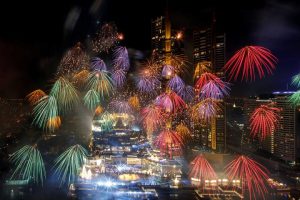Fortifications of Bangkok
As of April 2018, all remaining residents have been evicted, and plans are underway to tear the remaining buildings down. Another section of the city wall, 40 metres (130 ft) in length, along with a tower gate, remains in front of Wat Bowonniwet (13°45′36″N 100°30′06″E / 13.76000°N 100.50167°E / 13.76000; 100.50167). The wall here is 1.8 metres (5 ft 11 in) thick and 6 metres (20 ft) high. In July 2018, BMA was completely developed surrounding area of Mahakan Fort to become a public park and the fort exhibition. However, the Mahakan Fort Community’s Facebook page has announced an initiative to create an online database about the Mahakan Fort community, and is crowdsourcing information about the site.
These structures, as well as the canals that formed the city moats, are listed as registered ancient monuments. The fort, along with the royal palace of Thonburi, had been given for the establishment of the Royal Thai Naval Academy in 1903, and became home to the Navy’s headquarters after the academy relocated in 1946. A gaff-rigged flagpole was erected in 1971, and has since been used to fly the Naval Ensign. Wichaiprasit Fort (13°44′32″N 100°29′27″E / 13.74222°N 100.49083°E / 13.74222; 100.49083) is now part of the Royal Thai Navy Headquarters. The fort has been used ceremonially for the firing of gun salutes since 1979, when Memorial Bridge was permanently lowered, preventing warships from sailing upriver to perform the task.
Fourteen defensive forts were built along the walls, and 63 gates provided access to the walled city. The wall section in front of Wat Bowonniwet features the last remaining of the 16 tower gates. The rest were simple doors in the wall. Of the 63 city gates, 16 were tower gates with pointed roofs. All the gates bore enchantments warding off evil spirits, except for the gate known as Pratu Phi (ประตูผี, “Ghost Gate”), which was used to transport dead bodies out of the city.
Mahakan Fort is the easternmost fort of Rattanakosin’s walls, now situated next to Phan Fa Lilat Bridge of Ratchadamnoen Avenue and the junction of Khlong Maha Nak (the beginning of Saen Saep Canal) and Khlong Rop Krung (13°45′20″N 100°30′20″E / 13.75556°N 100.50556°E / 13.75556; 100.50556). The fort, also octagonal in shape and in three levels, has a diameter of 38 metres (125 ft) and a height of 19 metres (62 ft), measured to the roof of the octagonal tower.
Wang Tha Phra Library, Silpakorn University. International Council on Monuments and Sites. Mydans, Seth (4 January 2017). “Fighting Restoration by Clinging to Remnants of the Past”. ICOMOS Thailand. “Thailand: Cooperation on cultural heritage conservation”. The New York Times. In Petzet, Michael; Ziesemer, John (eds.). สวนสาธารณะป้อมมหากาฬ” อย่างเป็นทางการวันนี้”. ICOMOS World Report 2006-2007 on Monuments and Sites in Danger (PDF).


